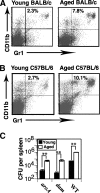Conditions that diminish myeloid-derived suppressor cell activities stimulate cross-protective immunity
- PMID: 18765736
- PMCID: PMC2573365
- DOI: 10.1128/IAI.00759-08
Conditions that diminish myeloid-derived suppressor cell activities stimulate cross-protective immunity
Abstract
Immunity conferred by conventional vaccines is restricted to a narrow range of closely related strains, highlighting the unmet medical need for the development of vaccines that elicit protection against multiple pathogenic serotypes. Here we show that a Salmonella bivalent vaccine comprised of strains that lack and overproduce DNA adenine methylase (Dam) conferred cross-protective immunity to salmonella clinical isolates of human and animal origin. Protective immunity directly correlated with increased levels of cross-reactive opsonizing antibodies and memory T cells and a diminished expansion of myeloid-derived suppressor cells (MDSCs) that are responsible for the immune suppression linked to several conditions of host stress, including chronic microbial infections, traumatic insults, and many forms of cancer. Further, aged mice contained increased numbers of MDSCs and were more susceptible to Salmonella infection than young mice, suggesting a role for these cells in the immune declines associated with the natural aging process. These data suggest that interventions capable of reducing MDSC presence and activities may allow corresponding increases in B- and T-cell stimulation and benefit the ability of immunologically diverse populations to be effectively vaccinated as well as reducing the risk of susceptible individuals to infectious disease.
Figures




Similar articles
-
Salmonella DNA adenine methylase mutants confer cross-protective immunity.Infect Immun. 2001 Nov;69(11):6725-30. doi: 10.1128/IAI.69.11.6725-6730.2001. Infect Immun. 2001. PMID: 11598044 Free PMC article.
-
Development of a Salmonella cross-protective vaccine for food animal production systems.Vaccine. 2015 Jan 1;33(1):100-7. doi: 10.1016/j.vaccine.2014.11.012. Epub 2014 Nov 20. Vaccine. 2015. PMID: 25448106
-
Cross-protective immunity conferred by a DNA adenine methylase deficient Salmonella enterica serovar Typhimurium vaccine in calves challenged with Salmonella serovar Newport.Vaccine. 2008 Mar 25;26(14):1751-8. doi: 10.1016/j.vaccine.2008.01.018. Epub 2008 Feb 4. Vaccine. 2008. PMID: 18329764
-
T cell receptor-transgenic mouse models for studying cellular immune responses to Salmonella in vivo.FEMS Immunol Med Microbiol. 2003 Jul 15;37(2-3):105-9. doi: 10.1016/S0928-8244(03)00064-6. FEMS Immunol Med Microbiol. 2003. PMID: 12832113 Review.
-
Vaccination and early protection against non-host-specific Salmonella serotypes in poultry: exploitation of innate immunity and microbial activity.Epidemiol Infect. 2005 Dec;133(6):959-78. doi: 10.1017/S0950268805004711. Epidemiol Infect. 2005. PMID: 16274493 Free PMC article. Review.
Cited by
-
CD11b+ Ly6Chi Ly6G- immature myeloid cells recruited in response to Salmonella enterica serovar Typhimurium infection exhibit protective and immunosuppressive properties.Infect Immun. 2014 Jun;82(6):2606-14. doi: 10.1128/IAI.01590-13. Epub 2014 Apr 7. Infect Immun. 2014. PMID: 24711563 Free PMC article.
-
Immunosenescence: the potential role of myeloid-derived suppressor cells (MDSC) in age-related immune deficiency.Cell Mol Life Sci. 2019 May;76(10):1901-1918. doi: 10.1007/s00018-019-03048-x. Epub 2019 Feb 20. Cell Mol Life Sci. 2019. PMID: 30788516 Free PMC article. Review.
-
G-MDSCs promote aging-related cardiac fibrosis by activating myofibroblasts and preventing senescence.Cell Death Dis. 2021 Jun 8;12(6):594. doi: 10.1038/s41419-021-03874-7. Cell Death Dis. 2021. PMID: 34103476 Free PMC article.
-
The Role of Aging and Senescence in Immune Checkpoint Inhibitor Response and Toxicity.Int J Mol Sci. 2024 Jun 27;25(13):7013. doi: 10.3390/ijms25137013. Int J Mol Sci. 2024. PMID: 39000121 Free PMC article. Review.
-
Implications of Inflammatory States on Dysfunctional Immune Responses in Aging and Obesity.Front Aging. 2021 Sep 22;2:732414. doi: 10.3389/fragi.2021.732414. eCollection 2021. Front Aging. 2021. PMID: 35822048 Free PMC article. Review.
References
-
- Almand, B., J. I. Clark, E. Nikitina, J. van Beynen, N. R. English, S. C. Knight, D. P. Carbone, and D. I. Gabrilovich. 2001. Increased production of immature myeloid cells in cancer patients: a mechanism of immunosuppression in cancer. J. Immunol. 166678-689. - PubMed
-
- al-Ramadi, B. K., Y. W. Chen, J. J. Meissler, Jr., and T. K. Eisenstein. 1991. Immunosuppression induced by attenuated Salmonella. Reversal by IL-4. J. Immunol. 1471954-1961. - PubMed
-
- al-Ramadi, B. K., J. J. Meissler, Jr., D. Huang, and T. K. Eisenstein. 1992. Immunosuppression induced by nitric oxide and its inhibition by interleukin-4. Eur. J. Immunol. 222249-2254. - PubMed
-
- al-Ramadi, B. K., M. A. Brodkin, D. M. Mosser, and T. K. Eisenstein. 1991. Immunosuppression induced by attenuated Salmonella. Evidence for mediation by macrophage precursors. J. Immunol. 1462737-2746. - PubMed
-
- Anderson, R. J., J. K. House, B. P. Smith, H. Kinde, R. L. Walker, B. J. Vande Steeg, and R. E. Breitmeyer. 2001. Epidemiologic and biological characteristics of salmonellosis in three dairy herds. J. Am. Vet. Med. Assoc. 219310-322. - PubMed
Publication types
MeSH terms
Substances
Grants and funding
LinkOut - more resources
Full Text Sources
Other Literature Sources
Molecular Biology Databases

